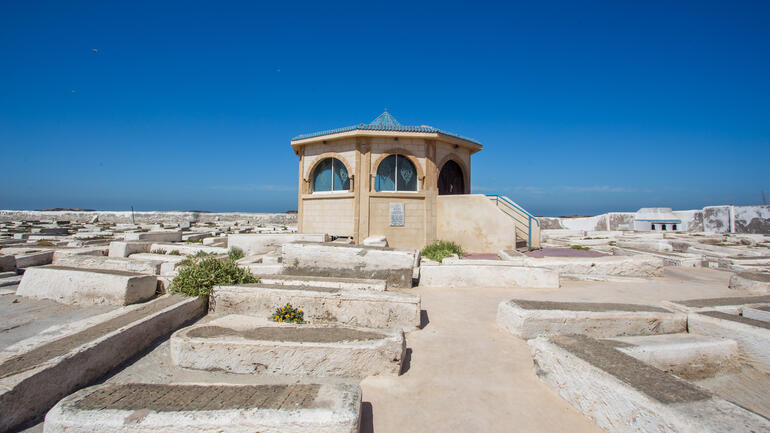
Jewish Cemetery (and Tomb of Rabbi Haim Pinto)
Before we enter the Mellah, just outside of its walls are some of the most prominent places linked to the Jewish heritage of Essaouira - the two Jewish cemeteries. Their size, and how there are now two, shows the former prominence of the Jewish community of Essaouira. The newer cemetery even had a burial as recent as 2010.
The older cemetery facing the Atlantic coast was used up until the 18th century, when the growing Jewish population made a second cemetery necessary. Prominent figures of Essaouira’s Jewish community are buried here, including a mausoleum for Haim Pinto where people come to pay their respects to the Tzadik.
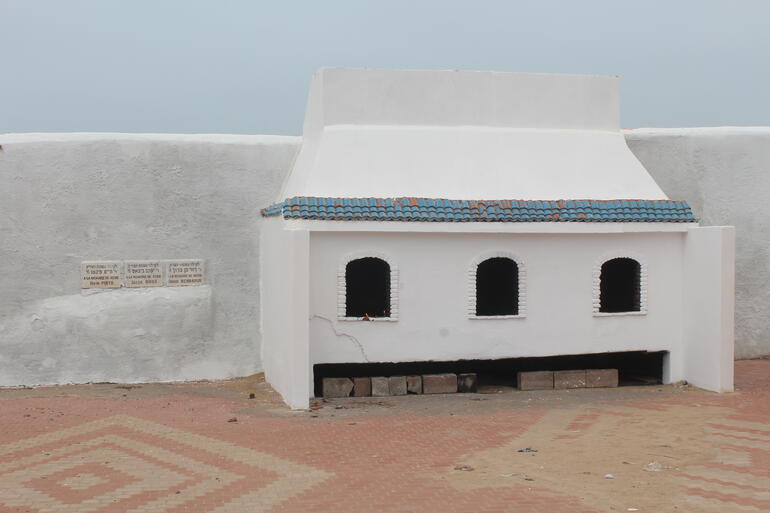
Asher Knafo, great grandson of the Rabbi of Slat Lkahal Synagogue which we will find later in this tour on Rue Mellah, is now transcribing the inscriptions of the cemetery’s tombstones designed by David Elkaïm, a well-known stone mason and poet of the town. Elkaïm was not only a Rabbi, but also an artist and known for his beautifully-decorated ketubahs (marriage certificates). Elkaïm also wrote his poetry in Hebrew long before the state of Israel was created and the language was revived. Some of his poems can be found the tombstones in these cemeteries. According to Sidney, Elkaïm is slowly being recognized as a significant writer in Hebrew poet, also because of the texts he wrote about Palestine, maintaining the connection between Morocco and the Holy Land.
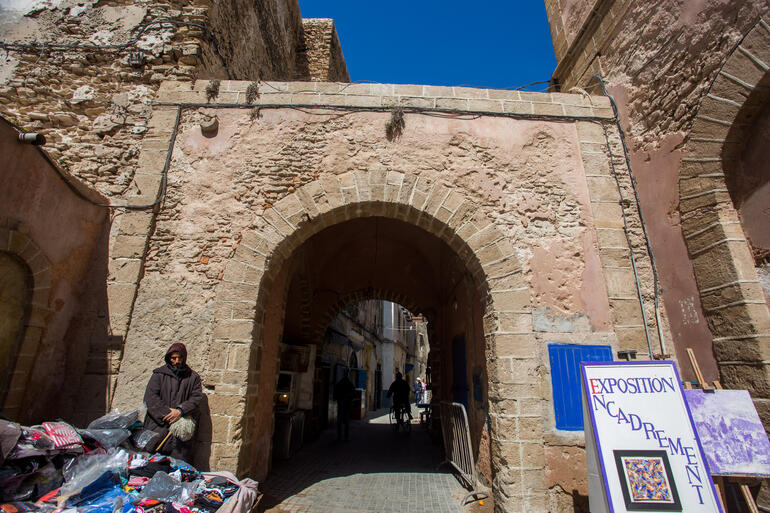
Porte du Mellah
Past the cemeteries is the main gate to the Mellah, often referred to as the Jewish Quarter, which today serves as the entry point to explore the past and present of the Jewish community of Essaouira, then known as Mogador. The Mellah became a largely Jewish community in the 18th century, when Sultan Sidi Mohammed Ben Abdellah transformed the town into a major trading port of Morocco. He invited merchants to come to Essaouira to handle the trade with Europe in his name, including ten famous Jewish merchants. These families came to be known as the Sultan’s merchants (Tujar Sultan), and often resided not in the Mellah, but in the Elite’s Kasbah, the governmental quarter.
Throughout Morocco at this time, there were many well-established Berber Jewish communities, as well as many Sephardic Jews who had migrated to Morocco after the expulsion of Jews and Muslims from the Iberian Peninsula in the 15th century.
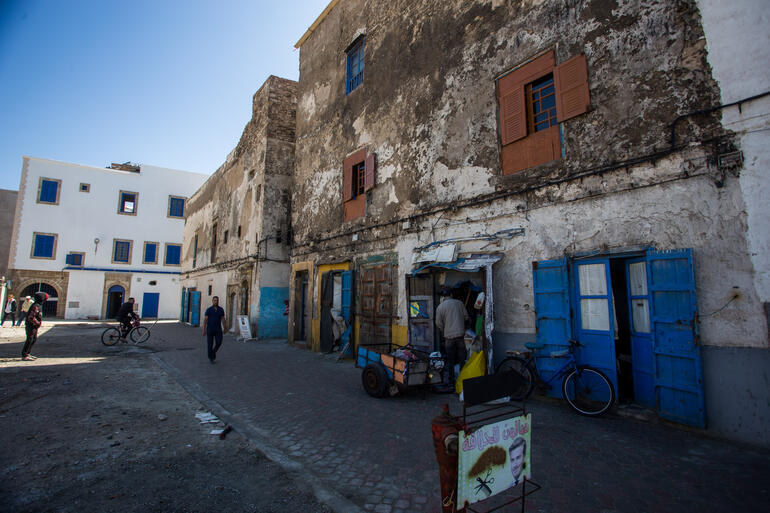
Rue Mellah (formerly Rue Moise)
Heading in from the Porte du Mellah, we make our way onto Rue Mellah itself, formerly known as Rue Moise, which is the main street through the neighborhood. The street makes its way past the watchtower (Burj El Mellah) and along the battlements, eventually leading into (Place Ataraa), the former spices market. Like in many other medieval Moroccan cities, Medinas, the Mellah had specific entrances in the form of gates.
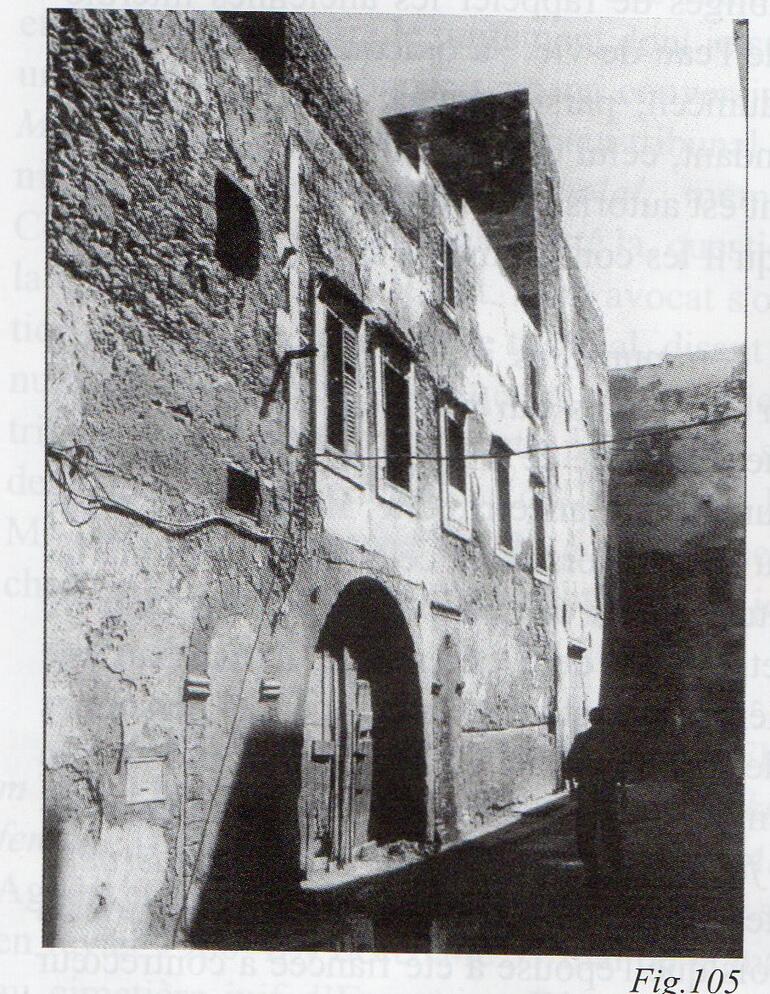
Mahia Distillery (demolished)
The first site related to the Jewish Heritage of Essaouira you encounter when walking down Rue Mellah is unfortunately demolished. It was the site of the former Mahia distillery. Mahia is a translation for Eau de vie, Water of Life, a liquor made traditionally of figs or dates, which is a product of Moroccan Jews.
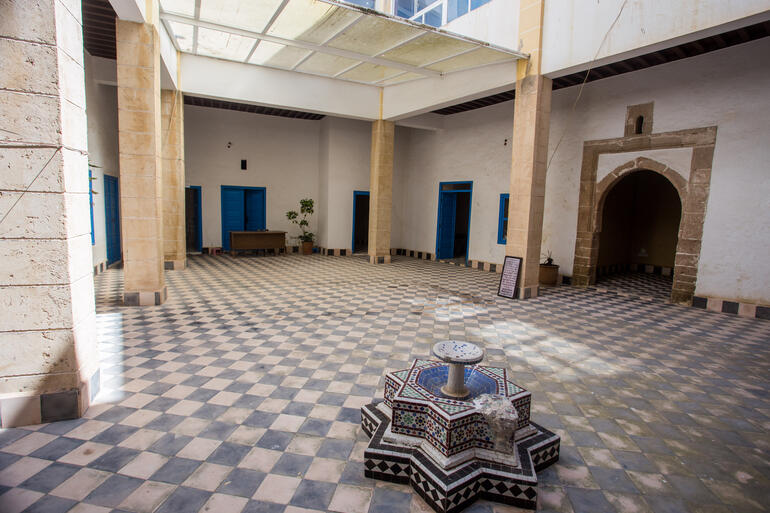
Maison Du Quartier (former Talmud Torah)
A few meters down the street from the site of the former Mahia distillery is the Maison du Quartier, which used to be a Talmud Torah.
David Bouhadana, a local resident who visited the Talmud Torah in the 1960s explains how “there was a nursery at the bottom for children from 6 to 10 years old, the bottom of Talmud, had two sides, a nursery side, and food for the poor [such as] oil, flour, etc...everything worked until the years 65-69 due to lack of population, since the Jews left the Mellah...very few families remained. After 1967 this establishment was renovated and ceded to the city authorities”. Today, the space is still used for civic iniatives and as a kindergarten.
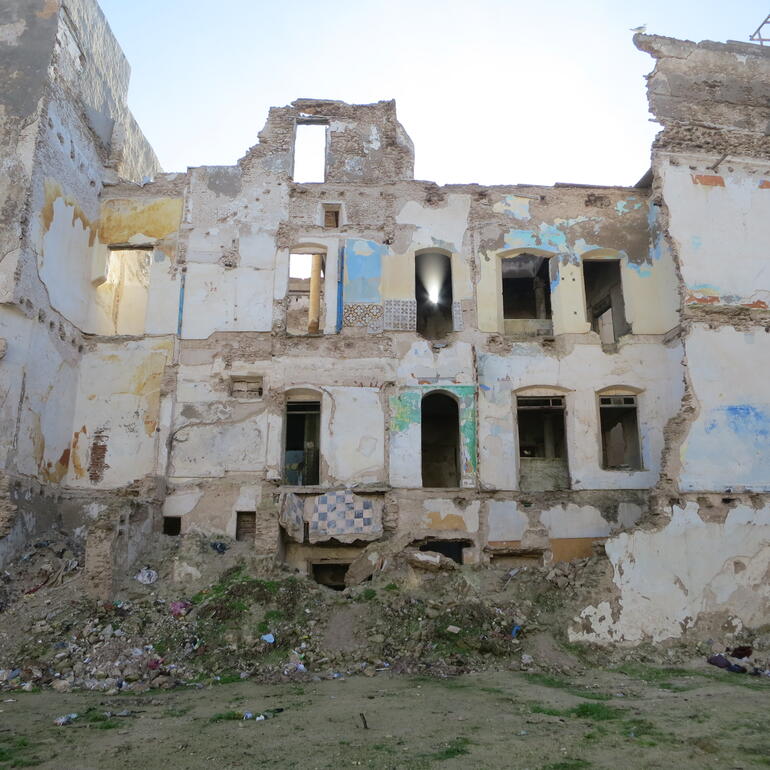
Cleared Area
Continuing on Rue Mellah, you pass a wall that seals off a large empty area where buildings have been demolished. From time to time holes appear in the wall and you can wander between the ruins and adjacent buildings. Only the former front of a building separates the Mellah from the busy Avenue Zerktouni behind. Like the former Mahia distillery, much of the tangible, built heritage of Jewish history in Essaouira continues to be at risk of demolition.
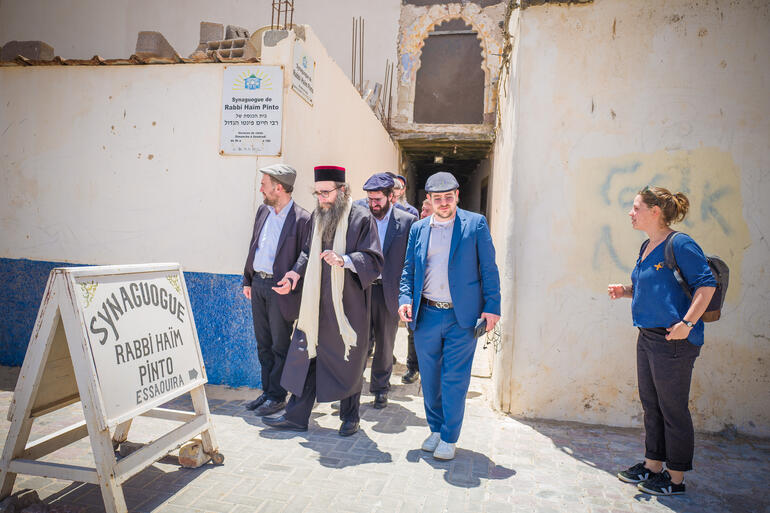
Haim Pinto Synagogue
Just past the cleared area is Haim Pinto’s home and Synagogue, one of the most well-known places in the Jewish community of Essaouira.
Rabbi Haim Pinto (1748–1845) is considered a Tzadik, a righteous person, and his Hiloula (Yahrzeit), the anniversary of his death, brings many people into the town to celebrate his legacy and pay the tribute on the 26 Elloul (the date falls between August and October in the Gregorian calendar). A sign points visitors of the Mellah into the direction of the synagogue, located in a small alley just off Rue Mellah.
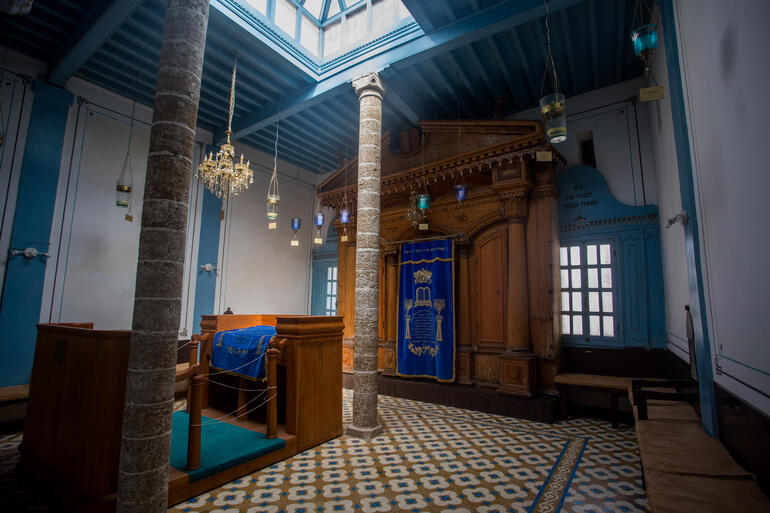
Slat Lkahal Mogador
A few metres further down the road from Haim Pinto is another synagogue, Slat Lkahal. Rather than being built solely by an affluent family, Slat Lkahal had many members of the Jewish community contribute to covering the costs of its construction, thereby making it into a true synagogue of the community. It was built on a large communal space on top of five arches leading to Rue Moise and used to be the synagogue of Asher Knafo’s great grandfather.
Slat Lkahal has been restored with the help of donations and had its second inauguration in 2017, reopening with a small photo exhibition about the Mellah and its Jewish community.
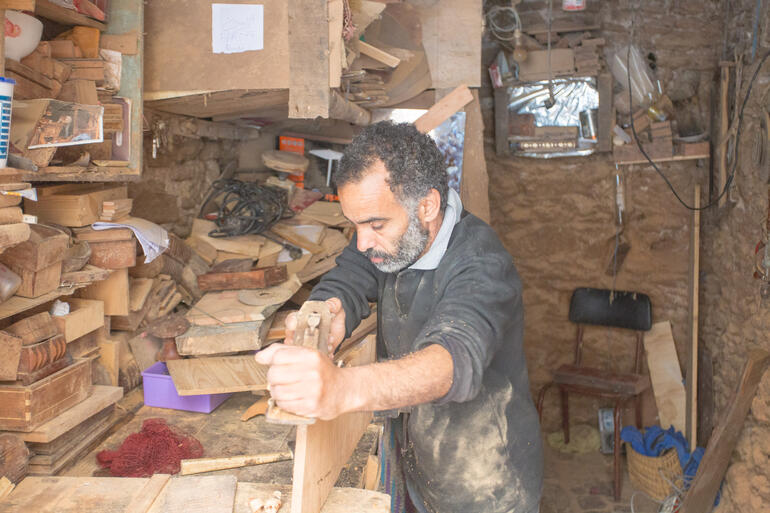
Carpenter Workshop
Continuing down Rue Mellah, the carpenter workshop belonging to Abdelmajid is on the left just past Slat Lkahal. He explains how the specific craft he is practising is the carpentry and carving of Thuya wood.
“It’s pretty well-known that it was brought by the Jewish community from Syria,” he explains, “They were the link between the way of the Berbers and the Middle Eastern people before the Arabs came here. So the handicraft from this region met the material of the Thuya wood and produced this art we continue to practice now. The Jewish community practiced all types of artisan work and handicraft and also excelled in jewelry.”
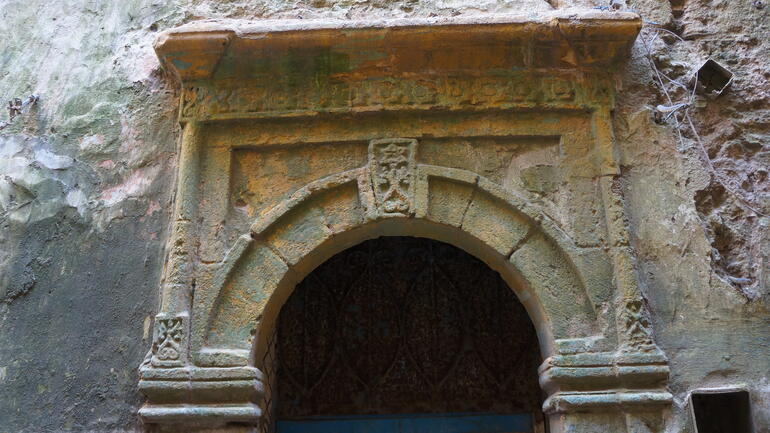
Door Emblems
Apart from the synagogues and former schools along Rue Mellah, there are also several smaller, much less prominent signs of the Jewish history and identity of the town. An attentive observer will notice symbols such as a Star of David or a stylized Menorah in the decor above many doors in the Medina. Many of them are obviously in the Mellah, but also throughout the Kasbah and other residential neighborhoods nearby. Jewish residents displayed their religious affiliation above the main door of their homes, just like their Muslim neighbors did.

Place Taraa
Rue Mellah ends in Place Taraa, today a small square with many small restaurants and cafés. The former resident David Bouhadana remembers that Place Taraa used to be where "people from the nearby villages arrived in the evening around five in the afternoon to sell the milk or butter...There also used to be a synagogue, Slat Taraa, also known as Slat Rabi Ayad, at the corner where Place Taraa connects with Avenue Sidi Mohamed Ben Abdellah."
Hear the stories from the Jewish Quarter of Essaouira, Morocco, by exploring What It Was, Who Left, and Who Remains.
Special thanks to the David Berg Foundation and the Jewish Heritage Endowment, whose generous support made documentation of this special site possible.
Hundreds of Jewish cultural sites around the world are in danger of disappearing forever, but you can make a difference for these irreplaceable sites with your gift. Learn more and join our efforts today!
